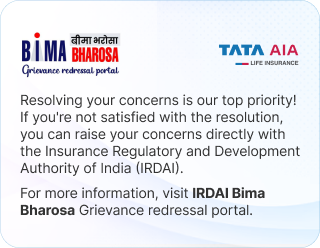Ever since the global world witnessed the pandemic, individuals have started considering investment options to secure their financial positions and protect their families simultaneously. For this, ULIP plans are considered one of the popular options. It offers various flexible features to customise the plan based on your financial needs. The plan also qualifies for various tax* provisions under the Income Tax Act, 1961. Therefore, if you plan to invest in a a ULIP plan, you must understand the features to maximise the returns while saving on tax. This article explains everything you need to know about ULIP taxation.
What is a ULIP policy?
A unit-linked insurance plan (ULIP) is an insurance product which offers the dual benefit of investment and insurance. The premiums paid towards a ULIP are divided into two parts. A part of your premiums goes towards securing life insurance coverage, while the rest is invested in market-linked funds of your choice to generate returns. ULIP helps you to achieve your long-term goals along with securing your loved ones in your absence. One can acquire both financial security and an opportunity to grow their savings with ULIP.
What is the meaning of tax benefits in ULIP?
Taxes are levied on income earned by the people of India. But there are a few investment instruments for which tax* deduction is allowed, and ULIP premium is among those. Under Section 80C of the Income Tax Act, 1961, up to ₹1.5 lakh is deductible per financial year.
How do tax benefits work in ULIP plans?
Let's take Arjun's example:
Now, suppose Arjun makes an investment in a ULIP to save his daughter's higher education. The ULIP offers a total sum assured of ₹18 lakh for a regular annual premium of ₹2.1 lakh. Let us now evaluate the deduction* under Section 80C that Arjun can claim on this ULIP premium paid. According to the tax laws, Arjun can claim a deduction* of the premium paid up to 10% of the total sum assured. Thus, Arjun can claim a deduction of up to ₹1.5 lakh paid as premium towards ULIP from his taxable income and not the entire ₹2.1 lakh, if he is not claiming any other deduction* under Section 80C.
Let us take another example. Suppose Arjun purchases a ULIP which offers a sum assured of ₹18 lakh. For this, the premium amount he needs to pay is ₹1.3 lakh each year. Under Section 80C, Arjun can get a deduction* of the entire premium he pays towards the ULIP plan he purchased, if he does not claim any other deduction under the same section.

ULIP Taxation: Key Points to Know
ULIP plan tax* benefits depend on factors like when you buy the policy, how much premium you pay, and the sum assured. This may help you make informed decisions and plan tax savings accordingly.
Budget 2025 Update
The ₹2.5 lakh cap is on the total annual ULIP premiums paid by a policyholder in a financial year and not on individual policies. This was brought in to prevent tax arbitrage, where people were using ULIPs primarily as tax-free* investments. However, death benefits under ULIPs are totally tax-free*, irrespective of the premium amount or date of issue of the policy.
How is ULIP taxed according to the budget 2025 decision?
The Union Budget 2025 has brought in a clarification under Section 10(10D) for ULIP maturity proceeds. Now, even if the annual premium does not exceed ₹2.5 lakh, once the limit of 10% of amount assured is crossed, the whole maturity amount is taxed as income from capital gains. However, death benefits will continue to be tax-free*.
ULIP tax benefits
ULIPs offer tax* benefits at different stages of your policy. Understanding these benefits helps you save on taxes while building wealth for your future goals.
Tax deductions* on premium payments (Section 80C)
The premiums paid towards ULIPs are deductible* under Section 80C of the Income Tax Act, 1961, hence providing a potential relief of up to ₹1.5 lakh in that financial year. This is considered a tax-effective investment, as the deduction* reduces the policyholder's taxable income. ULIPs allow one to combine insurance with the benefit of investment and the opportunity to create long-term wealth.
Tax exemption on life cover payout [Section 10(10D)]
Death benefit from a ULIP is completely exempted* from taxation under Section 10(10D) of the Income Tax Act, 1961. Since the exemption comprises both the sum assured and the built-up fund value or bonus1, the nominee gets the entire benefit tax-free*.
Are ULIPs completely tax-free?
The maturity proceeds from ULIPs could either be tax-free* or taxable. It depends on the date of issuance of the policy and its premium conditions. The table below summarises the applicable tax treatment under various scenarios:
Policy issue date |
Conditions for tax-free* maturity |
Taxability if conditions not met |
On or after 1 Feb 2021 |
Annual premium ≤ ₹2.5 lakh and Premium ≤ 10% of sum assured |
Taxable under Section 112A as Long-Term Capital Gains (LTCG), 12.5% LTCG tax on gains exceeding ₹1.25 lakh/year |
1 Apr 2012 to 31 Jan 2021 |
Premium ≤ 10% of the sum assured |
Taxable under Section 112A as Long-Term Capital Gains (LTCG), 12.5% LTCG tax on gains exceeding ₹1.25 lakh/year |
Before 1 Apr 2012 |
Premium ≤ 20% of the sum assured |
Taxable under Section 112A as Long-Term Capital Gains (LTCG), 12.5% LTCG tax on gains exceeding ₹1.25 lakh/year |
ULIP maturity proceeds must meet the required sum assured to premium ratio for remaining tax-exempt under Section 10(10D) of the Income Tax Act, 1961, irrespective of the issue date. Death benefits are tax-free*. Additionally, investors can use a ULIP calculator to correctly estimate the post-tax returns.
Understanding ULIP tax rules and their impact
The following section provides an overview of important tax provisions applicable to ULIPs including premium deduction*, maturity exemption, implications of LTCG, and death benefits.
Tax benefits* on premium payments
ULIPs are considered insurance investments for tax purposes under Section 80C of the Income Tax Act and can claim a tax deduction* on premium payment. Policyholders can avail deductions* for ₹1.5 lakh annually for annual premium, which does not exceed 10% of the sum assured, for policies taken on or after 1 April 2012. This reduces overall taxable income.
Taxability of maturity proceeds
Taxability of ULIP maturity proceeds depends on the issue date of the policy and the premium value. For policies issued from 1 February 2021, maturity shall be tax-free* only if the annual premium paid is ₹2.5 lakh or below and not more than 10 percent of the sum assured. Otherwise, the proceeds shall be taxed as long-term capital gains under Section 112A.
Exemption on Death Payout
Death benefit under a ULIP refers to the amount payable to the nominee on the death of the policyholder during the term of the policy. Such a benefit includes the sum assured and available fund value or bonuses1, as applicable, and is fully tax-free* under Section 10(10D) of the Income Tax Act. The exemption is irrespective of the high annual premium paid or a high sum assured to premium ratio. This makes ULIPs a safe financial instrument that offers protection to the nominee with tax-free* wealth transfer.
Tax implications on withdrawals and policy surrender
ULIPs have a lock-in period of five years from the date of issue. If you return the policy post lock-in, the surrender value minus the premiums shall be taxable as "Income from Capital Gains" if Section 10(10D) conditions are not met.
TDS is applicable if the policy doesn’t meet Section 10(10D) conditions, especially at the time when the premium is above 10% of the sum assured. The maturity proceeds become taxable, and TDS under Section 194DA is deducted* at 2% on the net income component, i.e., maturity amount minus total premiums paid. However, if the policy continues to meet the conditions of Section 10(10D), then any partial withdrawals made are exempt from the tax.
ULIP tax planning strategies
ULIP tax benefit planning strategies help the investors reduce taxation and receive returns on the policies. The following are some ULIP tax planning strategies.
Benefits under Section 80C deductions*
ULIP premiums are deductible* under Section 80C up to ₹1.5 lakh per year, reducing one's taxable income for the concerned financial year. Such a deduction* also assists long-term planning toward investments because ULIPs include a 5-year lock-in. Therefore, investors can try using this limit if other investments under Section 80C have not exhausted the limit.
Utilise the tax-free maturity option
ULIPs can offer tax-free* maturity proceeds under Section 10(10D). But there is a condition that the annual premium should be below ₹2.5 lakh-for policies issued after February 2021 and meets the sum-assured norms, whichever is applicable. Investors should read policy conditions carefully and make payments of premiums cautiously to keep themselves within the exemption* limit. This approach enables strategic wealth creation with long-term tax efficiency and optimisation of post-tax return.
Smartly use the fund switching benefit
ULIPs allow the benefit of switching between equity, debt, or balanced funds without paying capital gains tax. This allows the investor to adjust the investment to align it with changing market situations and risk appetite, which is easy compared to mutual funds, where switching between funds is taxed.
ULIP taxation with practical examples
Real-life examples help to better learn about tax on ULIP under various scenarios. For example, consider a policyholder who pays an annual premium of ₹2 lakh for a period of 10 years and receives ₹30 lakh on maturity. The entire amount is tax-exempt if the premium paid is less than Rs 2.5 lakhs, and the premium does not exceed 10% of the sum assured. In case the annual premium was higher at ₹3 lakh, more than the threshold of ₹2.5 lakh, gains in such a situation would be taxable as LTCG at 12.5% over ₹1.25 lakh.
Example 1: How premium amount affects ULIP taxation
The below example shows how the annual premium amount changes the ULIP taxation post-maturity under Section 10(10D) after the update provided in the 2021 budget.
Name |
Annual Premium |
Sum Assured |
Policy Term |
Total Premium Paid |
Maturity Amount |
Suresh |
₹90,000 |
₹16 lakh |
10 years |
₹9 lakh |
₹21 lakh |
Meena |
₹2.8 lakh |
₹32 lakh |
10 years |
₹28 lakh |
₹52 lakh |
Suresh: His annual premium is less than ₹2.5 lakh, so his maturity amount is fully exempt under Section 10(10D).
Meena: She pays more than ₹2.5 lakh/year as an annual premium; hence, exemption is not available.
Capital Gains: ₹52 lakh – ₹28 lakh = ₹ 24 lakh
Taxable LTCG: ₹24 lakh – ₹1.25 lakh = ₹22.75 lakh
Tax at 12.5%: ₹2.84 lakh plus applicable surcharge and cess
Insight: Paying premiums above ₹2.5 lakh makes ULIP maturity proceeds taxable even for equity-oriented policies.
Example 2: Tax-free maturity within premium limit
The example given below explains how Section 10(10D) tax* exemption works for policies purchased on or after 1 February 2021, where the annual premium is within ₹2.5 lakh.
Date of purchase: 5 April 2022
Annual premium: ₹2.4 lakh
Sum assured: ₹27 lakh
Policy term & maturity date: 10 years, ending on 5 April 2032
Maturity value received: ₹36 lakh
Since the annual premium does not exceed ₹2.5 lakh, the entire ₹36 lakh maturity amount is tax-free* as per Section 10(10D).
Insight: Sticking to the ₹2.5 lakh limit guarantees full exemption at maturity from tax, even if your gains are high.
Example 3: Taxation when premium exceeds the limit
The below example shows how the maturity proceeds in a ULIP will be taxed if the annual premium paid exceeds ₹2.5 lakh and the receipt of proceeds does not qualify for an exemption under Section 10(10D).
Policy Purchase Date |
20 July 2023 |
Annual Premium |
₹3.5 lakh |
Sum Assured |
₹42 lakh |
Policy Tenure |
20 years |
Total Premium Paid |
₹70 lakh |
Maturity Amount Received |
₹95 lakh |
Tax Treatment: Exemption under Section 10(10D) is not available since the annual premium exceeds ₹2.5 lakhs.
Capital gains: ₹95 lakh – ₹70 lakh = ₹25 lakh
LTCG up to ₹1.25 lakh is exempt. So, taxable LTCG = ₹23.75 lakh
12.5% LTCG tax = ₹2.97 lakh
Insight: High annual premiums make maturity proceeds of ULIPs taxable as capital gains.
Conclusion
ULIPs help you save funds and protect your family at the same time. You get tax* benefits when you pay premiums under Section 80C up to ₹1.5 lakh every year. Your maturity amount stays tax-free* if you pay less than ₹2.5 lakh premium annually, and it does not exceed 10% of your sum assured. Another important advantage is that death benefits are always tax-free*. So, plan your ULIP investments carefully to stay within tax limits. Make smart use of the fund switching option and choose the right premium amount to make the most of your returns with savings on taxes.











 FOR EXISTING POLICY
FOR EXISTING POLICY 
 FOR NEW POLICY
FOR NEW POLICY 








